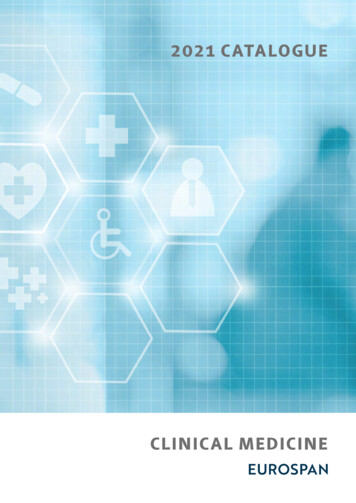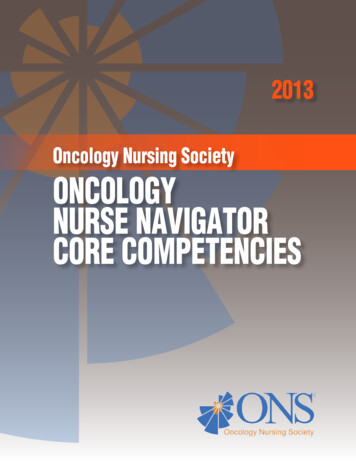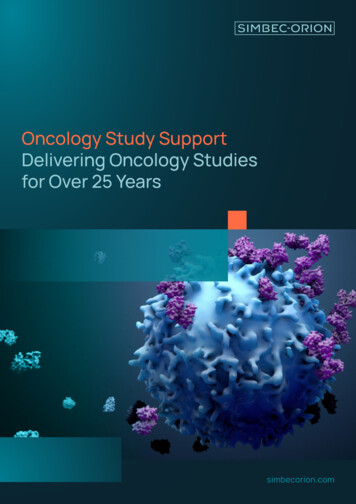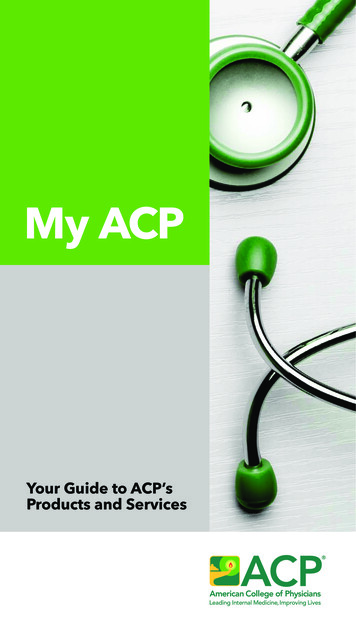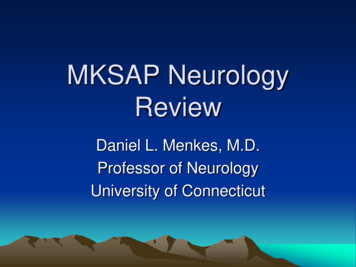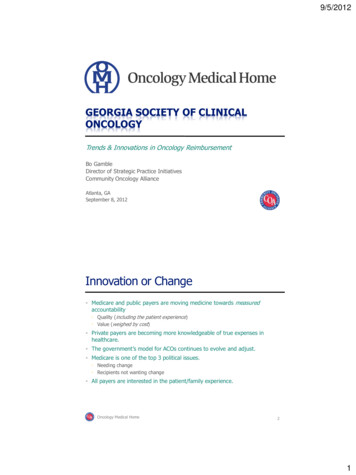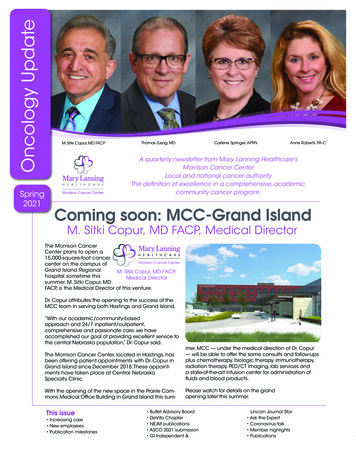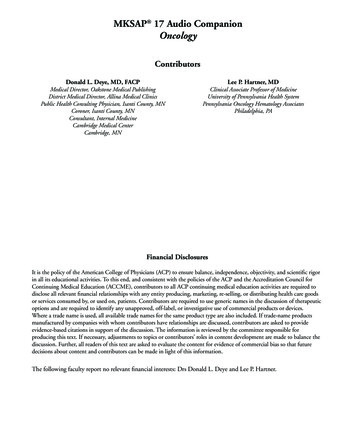
Transcription
MKSAP 17 Audio CompanionOncologyContributorsDonald L. Deye, MD, FACPLee P. Hartner, MDMedical Director, Oakstone Medical PublishingDistrict Medical Director, Allina Medical ClinicsPublic Health Consulting Physician, Isanti County, MNCoroner, Isanti County, MNConsultant, Internal MedicineCambridge Medical CenterCambridge, MNClinical Associate Professor of MedicineUniversity of Pennsylvania Health SystemPennsylvania Oncology Hematology AssociatesPhiladelphia, PAFinancial DisclosuresIt is the policy of the American College of Physicians (ACP) to ensure balance, independence, objectiv ity, and scientific rigorin all its educational activities. To this end, and consistent with the policies of the ACP and the Accreditation Council forContinuing Medical Education (ACCME), contributors to all ACP continuing medical education activities are required todisclose all relevant financial relationships with any entity producing, marketing, re-selling, or distributing health care goodsor services consumed by, or used on, patients. Contributors are required to use generic names in the discussion of therapeuticoptions and are required to identify any unapproved, off-label, or investigative use of commercial products or devices.Where a trade name is used, all available trade names for the same product type are also included. If trade-name productsmanufactured by companies with whom contributors have relationships are discussed, contributors are asked to provideevidence-based citations in support of the discussion. The information is reviewed by the committee responsible forproducing this text. If necessary, adjustments to topics or contributors’ roles in content development are made to balance thediscussion. Further, all readers of this text are asked to evaluate the content for evidence of commercial bias so that futuredecisions about content and contributors can be made in light of this information.The following faculty report no relevant financial interests: Drs Donald L. Deye and Lee P. Hartner.
MKSAP 17 Audio CompanionOncologyTable of ContentsSession 101 Introduction to Oncology Section02 Issues In Oncology03 Staging04 Performance StatusTable 48. Oncology Performance Status Systems05 Question Break 1 A 57-year-old Woman With BilateralAtypical Ductal Hyperplasia is Evaluated06 Goals of Therapy07 Understanding Cancer Terminology08 Treatment Approaches09 Conversion Therapy10 Question Break 2 An 80-year-old Woman is HospitalizedAfter a Mechanical Fall11 Personalized Medicine12 Other Examples of Personalized Medicine13 Epidemiology and Risk Factors of Breast CancerTable 49. Breast Cancer Risk Factors14 Highlights Of NCCN Criteria For Breast and Ovarian CancerTable 50. Highlights Of NCCN Criteria For Breast and/orOvarian Cancer15 Session 1 Key Points16 Close to Session 1Session 201 Introduction to Session 202 USPSTF Recommendations for Breast and OvarianCancer SyndromeTable 51. USPSTF Recommendations for Breast and/orOvarian Cancer Syndrome03 Chemoprevention and Other Risk Reduction StrategiesTable 52. Chemoprophylaxis Agents for Breast CancerRisk Reduction04 ACS Recommendations for MRI Breast Cancer ScreeningTable 53. ACS Recommendations for MRI BreastCancer Screening05 Staging and Prognosis of Early-Stage Breast CancerTable 54. Breast Cancer Stage and Survival06 Ductal Carcinoma In Situ07 Question Break 3 A 44-year-old Woman With Stage ICancer of the Breast is Evaluated08 Invasive Breast Cancer09 Adjuvant Systemic Therapy for NonmetastaticBreast Cancer10 Question Break 4 A 38-year-old Man is Seen for aPigmented Lesion on His Upper Back11 Adjuvant Chemotherapy12 Locally Advanced and Inflammatory Breast CancerFigure 15. Inflammatory Breast Cancer13 Breast Cancer Follow-Up and Survivorship14 Metastatic Breast Cancer15 Systemic Treatment16 Session 2 Key Points17 Close to Session 2Session 301 Introduction to Session 302 Epidemiology and Risk Factors of Ovarian CancerTable 55. Lifetime Risk Of Ovarian Cancer03 Screening and Risk-Reduction Strategies04 Diagnosis05 TreatmentTable 56. IFGO Ovarian Cancer Staging, Treatment,and toring and Follow-UpManagement of Recurrent Ovarian CancerQuestion Break 5 A 72-year-old Man Undergoes Follow-UpExam for Prostate CancerEpidemiology and Risk Factors of Cervical CancerDiagnosis, Staging, and TreatmentTable 57. IFGO Cervical Cancer StagingPrognosis and SurveillanceQuestion Break 6 A 35-year-old Man With Testicular CancerUndergoes Follow-Up EvaluationColorectal CancerStagingTable 58. Staging of Colorectal CancerSurgical ManagementRectal CancerColon CancerMetastatic DiseasePostoperative SurveillanceAnal CancerPancreatic CancerGastroesophageal CancerSession 3 Key PointsClose to Session 3Session 401 Introduction to Session 402 Neuroendocrine Tumors03 Gastrointestinal Stromal Tumors04 Lung Cancer05 Diagnosis and Staging of Non–Small Cell Lung Cancer06 Question Break 7 A 51-year-old Man is Evaluated for a3-Month History of Cough07 Treatment08 Metastatic Disease09 Maintenance Chemotherapy10 Diagnosis and Staging of Small Cell Lung Cancer11 Question Break 8 A 70-year-old Woman is Hospitalized forWorsening Weakness and Anorexia12 Treatment13 Risk Factors of Head and Neck Cancer14 Clinical Manifestations, Evaluation and StagingTable 59. AJCC TNM Staging System for Head andNeck Cancer15 Treatment16 Post-Treatment Surveillance17 Epidemiology and Risk Factors of Prostate Cancer18 Diagnosis and StagingTable 60. Prostate Cancer Risk Stratification19 Session 4 Key Points20 Close to Session 4Session 501 Introduction to Session 502 Treatment03 Metastatic Prostate Cancer04 Testicular Cancer05 Question Break 9 A 59-year-old Woman is Seen forLimited-Stage Small Cell Lung Cancer06 Renal Cell Carcinoma07 Bladder Cancer08 Question Break 10 A 78-year-old Man is Evaluated forHeadaches and Blurred Vision09 Epidemiology and Risk Factors of Lymphoid Malignancies
Table of Contents Pg 21011121314Evaluation and DiagnosisClassification, Staging, and Prognosis of MalignantLymphomaFigure 16. Ann Arbor Staging System for Hodgkin andNon-Hodgkin LymphomaFollicular LymphomaSession 5 Key PointsClose to Session 5Session 601 Introduction to Session 602 Mucosa-Associated Lymphoid Tissue Lymphoma03 Chronic Lymphocytic Leukemia04 Hairy Cell LeukemiaFigure 17. Hairy Cell Leukemia05 Diffuse Large B-Cell Lymphoma06 Mantle Cell Lymphoma07 Question Break 11 A 44-year-old Woman is Seen for aPainless Right Neck Mass08 Hodgkin Lymphoma09 Cutaneous T-Cell Non-Hodgkin Lymphoma10 Cancer of Unknown Primary Site11 Prognostic Subgroups of CUP12 Question Break 12 A 28-year-old Woman is Seen for aProgressive Headache With Nausea and Vomiting13 Nonfavorable Subgroups14 Treatment of Melanoma15 Immunotherapy Options161718Prognosis and Follow-UpSession 6 Key PointsClose to Session 6Session 701 Introduction to Session 702 Superior Vena Cava Syndrome03 Increased Intracranial Pressure04 Spinal Cord Compression05 Malignant Pleural and Pericardial Effusions06 Tumor Lysis Syndrome07 Hypercalcemia08 Effects of Cancer Therapy and SurvivorshipTable 61. Treatment-Related Toxicities09 Hematopoietic Toxicity, Neutropenia and Fever10 Thrombocytopenia, Anemia and Disorders ofPulmonary Function11 Disorders of Genitourinary and Renal Function12 Immune-Related Toxicities13 Late Effects of Cancer Therapy14 Disorders of Cardiac Function15 Sexual Function16 General Principals of Survivorship17 Cognitive Function After Cancer Therapy18 Other Issues for Survivors19 Session 7 Key Points20 Close to Oncology Section
MKSAP 17 Audio CompanionOncologyHighlights Most solid tumor malignancies are staged according to the “TNM” classification, in which “T” reflects tumor size orextent of local invasion (T1-4); “N” represents the degree of locoregional lymph node involvement (N0-N3),and “M” represents the absence or presence of nodal metastasis (M0-M1). The term performance status is used to indicate a patient’s well-being and ability to perform daily activities. In patients with incurable cancer, acknowledging that disease is incurable often leads to appropriate and adequateuse of analgesics and other comfort-oriented measures, whereas establishing unrealistic measures for outcomes mayimpede adequate symptom management. The term overall survival refers to the time from initiation of therapy until death and is frequently quoted as themedian survival time for a population of patients in a published study. The primary treatment for locoregional solid tumor malignancies is surgical resection, which is often combined withchemotherapy or radiation to potentially increase the cure rate. The goal of personalized medicine is to direct therapeutic approaches that are optimally beneficial to an individualpatient through a better understanding of the molecular makeup of the individual and the tumor. Breast cancer incidence increases with age, with 95% of cases developing in women older than 40 years, and incidenceis highest in non-Hispanic white women and second highest in black women. Women older than 35 years with a 5-year breast cancer risk of 1.7% or higher or with lobular carcinoma in situ oratypical ductal hyperplasia are candidates for breast cancer prophylaxis with tamoxifen prior to menopause and withtamoxifen, raloxifene, or exemestane after menopause. Clinical features associated with a more favorable prognosis of early-stage breast cancer include hormonereceptor–positive cancer, small tumor size, low tumor grade, and negative lymph nodes. Ductal carcinoma in situ (DCIS) can be treated with breast-conserving therapy or mastectomy if the disease is moreextensive or if clear margins cannot be obtained by a wide excision. Breast-conserving therapy is effective for patients with invasive breast cancer with tumors 5 cm or less involving asingle quadrant of the breast and clear margins after excision. In women with hormone receptor–positive breast cancer, antiestrogen therapy reduces the overall risk of local anddistant recurrence by 40% to 50% and the risk of contralateral breast cancer by 50% to 65%. Patients with hormone receptor–negative breast cancer generally have a greater benefit from adjuvant chemotherapy,with a proportional reduction in risk of recurrence compared with patients with hormone receptor–positivebreast cancer. Inflammatory breast cancer is characterized by erythema and edema of the skin of the breast, which can resemble theskin of an orange (“peau d’orange”); the diagnosis is established based on the clinical appearance of the breast. After completion of treatment, follow-up monitoring in patients with early-stage breast cancer should occur every3 to 6 months for 2 years, every 6 months during years 2 through 5, and then annually, with annual mammographyfor all survivors, and MRI of the breast reserved for those at high risk for recurrence. Recurrent breast cancer with distant metastases is not curable, and the goals of treatment in such patients are toimprove survival, palliate symptoms, and minimize treatment toxicity.
Highlights Pg 2 All women with ovarian cancer are eligible for BRCA1/2 testing. Women at average risk for ovarian cancer should not receive ovarian cancer screening; the predictive values ofserum CA-125 testing and ultrasonography are each less than 3% and lead to a high rate of false-positive resultsand unnecessary surgeries. Severe or persistent symptoms such as abdominal or pelvic pain, bloating, early satiety, or anorexia should raisesuspicion for ovarian cancer, particularly in postmenopausal women. Surgical treatment of ovarian cancer should be done by a gynecologic oncologist and involves total abdominalhysterectomy and bilateral salpingo-oophorectomy; staging by examination of the abdomen and pelvis, includingperitoneal washings and lymph node evaluation; and optimal tumor debulking.MKSAP 17 Audio Companion Copyright 2015 American College of Physicians. All rights reserved.
MKSAP 17 Audio CompanionOncologyReferences Albain KS, Barlow WE, Shak S, et al; Breast Cancer Intergroup of North America. Prognostic and predictive valueof the 21-gene recurrence score assay in postmenopausal women with node-positive, oestrogen-receptor-positivebreast cancer on chemotherapy: a retrospective analysis of a randomised trial. Lancet Oncol. 2010 Jan;11(1):55-65.[PMID: 20005174] Amir E, Miller N, Geddie W, et al. Prospective study evaluating the impact of tissue confirmation of metastatic diseasein patients with breast cancer. J Clin Oncol. 2012 Feb 20;30(6):587-92. [PMID: 22124102] Armstrong DK, Bundy B, Wenzel L, et al; Gynecologic Oncology Group. Intraperitoneal cisplatin and paclitaxel inovarian cancer. N Engl J Med. 2006 Jan 5;354(1):34-43. [PMID: 16394300] Burstein HJ, Temin S, Anderson H, et al. Adjuvant endocrine therapy for women with hormone receptor-positivebreast cancer: american society of clinical oncology clinical practice guideline focused update. J Clin Oncol. 2014July 20:32(21);2255-69. [PMID: 24868023] Bang YJ, Van Cutsem E, Feyereislova A, et al; ToGA Trial Investigators. Trastuzumab in combination withchemotherapy versus chemotherapy alone for treatment of HER2-positive advanced gastric or gastro-oesophagealjunction cancer (ToGA): a phase 3, open-label, randomised controlled trial. Lancet. 2010 Aug 28;376(9742):687-97. Erratum in: Lancet. 2010 Oct 16;376(9749):1302. [PMID: 20728210] Agra Y, Pelayo M, Sacristan M, Sacristán A, Serra C, Bonfill X. Chemotherapy versus best supportive care for extensivesmall cell lung cancer. Cochrane Database Syst Rev. 2003;(4):CD001990. Update in: Cochrane Database Syst Rev.2009;(4):CD001990. [PMID: 14583943] Adelstein DJ, Li Y, Adams GL, et al. An intergroup phase III comparison of standard radiation therapy and twoschedules of concurrent chemoradiotherapy in patients with unresectable squamous cell head and neck cancer.J Clin Oncol. 2003 Jan 1;21(1):92-8. [PMID: 12506176] de Bono JS, Logothetis CJ, Molina A, et al; COU-AA-301 Investigators. Abiraterone and increased survival inmetastatic prostate cancer. N Engl J Med. 2011 May 26;364(21):1995-2005. [PMID: 21612468] Amador-Ortiz C, Chen L, Hassan A, et al. Combined core needle biopsy and fine-needle aspiration with ancillarystudies correlate highly with traditional techniques in the diagnosis of nodal-based lymphoma. Am J Clin Pathol.2011 Apr;135(4):516-24. [PMID: 21411774] Petrakis D, Pentheroudakis G, Voulgaris E, Pavlidis N. Prognostication in cancer of unknown primary (CUP):development of a prognostic algorithm in 311 cases and review of the literature. Cancer Treat Rev. 2013 Nov;39(7):701-8. [PMID: 23566573] Chapman PB, Hauschild A, Robert C, et al; BRIM-3 Study Group. Improved survival with vemurafenib in melanoma with BRAF V600E mutation. N Engl J Med. 2011 Jun 30;364(26):2507-16. [PMID: 21639808] Burazor I, Imazio M, Markel G, Adler Y. Malignant pericardial effusion. Cardiology. 2013;124(4):224-32.[PMID: 23571453] Galardy PJ, Hochberg J, Perkins SL, Harrison L, Goldman S, Cairo MS. Rasburicase in the prevention of laboratory/clinical tumour lysis syndrome in children with advanced mature B-NHL: a Children’s Oncology Group Report.Br J Haematol. 2013 Nov;163(3):365-72. [PMID: 24032600]MKSAP 17 Audio Companion Copyright 2015 American College of Physicians. All rights reserved.
TABLE 48. Oncology Performance Status SystemsECOG/WHO Performance Scalea0 – Fully active; no restrictions on activities1 – Unable to do strenuous activities, but able to carry out light housework and sedentary activities2 – Able to walk and manage self-care, but unable to work; out of bed more than 50% of waking hours3 – Confined to a bed or a chair more than 50% of waking hours; capable of limited self-care4 – Completely disabled. Totally confined to a bed or chair; unable to do any self-care5 – DeathKarnofsky Performance Scale100 – Normal; no symptoms or evidence of disease90 – Minor symptoms, but able to carry on normal activities80 – Some symptoms; normal activity requires effort70 – Unable to carry on normal activities, but able to care for self60 – Needs frequent care for most needs; some occasional assistance with self-care50 – Needs considerable assistance with self-care and frequent medical care40 – Disabled; needs special care and assistance30 – Severely disabled; hospitalized20 – Very ill; significant supportive care is needed10 – Actively dying0 – DeathECOG/WHO Eastern Cooperative Oncology Group/World Health Organization.aAlso called the Zubrod Score.MKSAP 17 Audio Companion Copyright 2015 American College of Physicians. All rights reserved.
TABLE 49. Breast Cancer Risk FactorsBreast Cancer Risk FactorCategoryBreast Cancer Risk FactorsIncrease in Breast CancerRisk or Lifetime BreastCancer RiskReproductive factorsEarly menarche, late menopause, firstfull-term pregnancy after age 30years, or nulliparousRR 1.2-3.5LifestyleObesity (BMI 30), lack of regularexercise, vitamin D deficiency, alcoholintakeRR 1.2-1.6Obesity: RR 1.6 for BMI 30.7 versusBMI 22.9 in postmenopausal womenaRegular exercise: RR decreased by25% in physically active womencompared with the least activewomenbVitamin D deficiency:Postmenopausal breast cancer riskdecreased by 12% for each 5 ng/mL(12.5 nmol/L) increase in 25(OH)Dlevels between 27 and 35 ng/mLc(67.4 and 87.4 nmol/L)Alcohol: mildly increased risk (RR1.05) with 2 to 3 drinks per week. RR1.41 for women consuming 2 to 5drinks per daydTreatment related: radiationPrior chest wall radiation in patientsyounger than age 30 years (e.g.,mantle radiation for Hodgkinlymphoma)RR 5.0, with highest risk for youngerage at radiation therapy; risk remainsincreased for at least 40 years afterradiation therapy, with 30% to 50%lifetime risk of breast cancereTreatment related: HRTCombination estrogen andprogesterone HRT after menopauseRR 1.2-1.4; increased risk begins after3 years of therapyaBreast densityfIncreased breast densityRisk increases with each category ofbreast density; for 75% density, RRis 4.7 compared with 10% densitygAtypical breast lesionsAtypical ductal or lobular hyperplasia,LCISRR 3.8-5.3 for atypical hyperplasiahand RR 5.4-8.0 for LCISi; 30% to 35%lifetime risk of breast cancer (bilateralrisk)h,iFamily history of breast cancer andfamilial breast cancer syndromesBRCA1/2 mutation represents themost common familial breast cancersyndrome (5% to 10% of all breastcancer tumors); others are rareBRCA1/2 mutations (RR 3.0 to 7.0)confer a 50% to 87% lifetime risk ofbreast cancer and a 20% to 45%lifetime risk of ovarian cancer25(OH)D 25-hydroxyvitamin D; HRT hormone replacement therapy; LCIS lobular carcinoma in situ; RR relative risk.aData from Clemons M, Goss P. Estrogen and the risk of breast cancer. N Engl J Med. 2001 Jan 25;344 (4):276-85. Erratum in: NEngl J Med. 2001 Jun 7;344(23):1804. [PMID: 11172156]bData from Lynch BM, Neilson HK, Friedenreich CM. Physical activity and breast cancer prevention. Recent Results Cancer Res.2011;186:13-42. [PMID: 21113759]cData from Bauer SR, Hankinson SE, Bertone-Johnson ER, Ding EL. Plasma vitamin D levels, menopause, and risk of breast cancer:dose-response meta-analysis of prospective studies. Medicine (Baltimore). 2013 May;92(3):123-31. [PMID: 23625163]dData from Bagnardi V, Rota M, Botteri E, et al. Light alcohol drinking and cancer: a meta-analysis. Ann Oncol. 2013Feb;24(2):301-8. [PMID: 22910838] and Smith-Warner SA, Spiegelman D, Yaun SS, et al. Alcohol and breast cancer in women: apooled analysis of cohort studies. JAMA. 1998 Feb 18;279(7):535-40. [PMID: 9480365]eData from Swerdlow AJ, Cooke R, Bates A, et al. Breast cancer risk after supradiaphragmatic radiotherapy for Hodgkin'slymphoma in England and Wales: a National Cohort Study. J Clin Oncol. 2012 Aug 1;30(22):2745-52. [PMID: 22734026]fBreast density refers to the amount of radiologically dense breast tissue appearing on a mammogram.gData from Boyd NF, Guo H, Martin LJ, et al. Mammographic density and the risk and detection of breast cancer. N Engl J Med.2007 Jan 18;356(3):227-36. [PMID: 17229950]hData from Degnim AC, Visscher DW, Berman HK, et al. Stratification of breast cancer risk in women with atypia: a Mayo cohortstudy. J Clin Oncol. 2007 Jul 1;25(19):2671-7. [PMID: 17563394] and Marshall LM, Hunter DJ, Connolly JL, et al. Risk of breastcancer associated with atypical hyperplasia of lobular and ductal types. Cancer Epidemiol Biomarkers Prev. 1997 May;6(5):297301. [PMID: 9149887]iData from Bodian CA, Perzin KH, Lattes R. Lobular neoplasia. Long term risk of breast cancer and relation to other factors. Cancer.1996 Sep 1;78(5):1024-34. [PMID: 8780540]MKSAP 17 Audio Companion Copyright 2015 American College of Physicians. All rights reserved.
TABLE 50. Highlights of NCCN Criteria for Breast and/or Ovarian Cancer SyndromeGenetic TestingaIndividual with a family history of a known deleterious BRCA1/2 mutationIndividual with breast cancer diagnosed before age 45 yearsIndividual with breast cancer diagnosed before age 50 years if family history includes very few female first- or second-degreerelatives or if one relative is diagnosed with breast cancer at any ageIndividual with breast cancer diagnosed at any age if one or more relatives is diagnosed with epithelial ovarian cancerBreast cancer in women of Ashkenazi (Eastern European) Jewish ancestryMen with breast cancer diagnosed at any ageIndividual with more than three family members b with breast cancer, ovarian cancer, pancreatic cancer, and/or aggressiveprostate cancerIndividual with triple-negative breast cancerc diagnosed before age 60 yearsIndividual with epithelial ovarian cancer diagnosed at any ageBCRA1/2 breast cancer susceptibility 1 or breast cancer susceptibility 2 genes; NCCN National Comprehensive Cancer NetworkaFull testing guidelines can be accessed at www.nccn.org/professionals/physician gls/f guidelines.aspbFirst-, second-, or third-degree relativescNegative for estrogen receptors, progesterone receptors, and HER2 amplificationMKSAP 17 Audio Companion Copyright 2015 American College of Physicians. All rights reserved.TABLE 51. U.S. Preventive Services Task Force Recommendationsa for Breast and/orOvarian Cancer Syndrome Genetic TestingbWomen of Non–Ashkenazi Jewish Heritage:Two first-degree relatives with breast cancer, one of whom received the diagnosis at age 50 years or youngerA combination of three or more first- or second-degree relatives with breast cancer regardless of age at diagnosisA combination of both breast and ovarian cancer among first- and second-degree relativesA first-degree relative with bilateral breast cancerA combination of two or more first- or second-degree relatives with ovarian cancer regardless of age at diagnosisA first- or second-degree relative with both breast and ovarian cancer at any ageA history of breast cancer in a male relativeWomen of Ashkenazi Jewish Heritage:Any first-degree relative (or two second-degree relatives on the same side of the family) with breast or ovarian canceraFull testing recommendations can be accessed enetic-testingbApplies to patients without a personal history of breast or ovarian cancer and without a known deleterious breast cancersusceptibility gene 1 (BRCA1) or breast cancer susceptibility gene 2 (BRCA2) mutation present in their family. Both maternal andpaternal family histories are important.MKSAP 17 Audio Companion Copyright 2015 American College of Physicians. All rights reserved.
TABLE 52. Chemoprophylaxis Agents for Breast Cancer Risk eneExemestaneMechanism of actionSERMSERMAromatase inhibitor:prevents conversion ofandrogens to estrogensDose (all are 5 years induration)20 mg/d orally60 mg/d orally25 mg/d orallyBreast cancer risk reduction49%Less effective thantamoxifen: retains 76% ofthe effectiveness oftamoxifen65%Important toxicitiesVasomotor symptoms,cataracts, vascular events(stroke, TIA, DVT and PE),and endometrial cancerand uterine sarcoma inpostmenopausal womenVasomotor symptoms,cataracts, vascular events(25% lower risk of vascularevents than tamoxifen)Vasomotor symptoms,arthralgia, headaches, andinsomniaIndicated for use inpremenopausal womenYesNot studied; should not beused unless part of aclinical trialNot effective inpremenopausal womenOtherContraindicated in womenwith prior thromboemboliceventsContraindicated in womenwith prior thromboemboliceventsAt 3-year follow-up, noincrease in osteoporosis,fractures, endometrialcancer, vascular events, orcardiac diseaseDVT deep venous thrombosis; PE pulmonary embolism; SERM selective estrogen receptor modulator; TIA transientischemic attack.MKSAP 17 Audio Companion Copyright 2015 American College of Physicians. All rights reserved.TABLE 53. American Cancer Society Recommendations for MRI Breast Cancer ScreeningWomen with BRCA1/2 mutationsWomen who are a first-degree relative of a BRCA1/2 carrier, but are untestedaWomen with a strong family history of breast cancer with a lifetime breast cancer risk of 20% to 25% as calculated bymodelsb largely dependent on family historyWomen who had radiation to the chest wall between ages 10 and 30 years (e.g., mantle radiation therapy for Hodgkinlymphoma)Women with a history of other rare familial breast cancer syndromesBRCA1/2 breast cancer susceptibility 1 or breast cancer susceptibility 2 genesaTesting for the BRCA1 or BRCA2 mutation that is present in the family is strongly recommended, but some patients decide to defertesting. In this situation where their carrier status is unknown, breast MRI screening is recommended. If they are later tested anddo not carry the mutation, MRI screening should be stopped.bModels that can be used to estimate lifetime risk of breast cancer to determine if MRI screening is appropriate (please note thatthe Gail Model is not recommended for this use): BRCAPRO: t.asp Claus model: Claus EB, Risch N, Thompson WD. The calculation of breast cancer risk for women with a first degreefamily history of ovarian cancer. Breast Cancer Res Treat. 1993 Nov;28(2):115–20. [PMID: 8173064] Tyrer-Cuzick (also called IBIS Breast Cancer Risk Evaluation Tool): www.ems-trials.org/riskevaluatorMKSAP 17 Audio Companion Copyright 2015 American College of Physicians. All rights reserved.
TABLE 54. Breast Cancer Stage and SurvivalStageTumor size and nodes5-year relative survivalI 2 cm, negative lymph nodes95%IIA 2 cm if 1 to 3 positive lymph nodes;2.1-5 cm if negative lymph nodes85%IIB2.1-5 cm with 1 to 3 positive lymphnodes; or 5 cm tumor with negativelymph nodes70%IIIAny tumor size with 4 positive axillarylymph nodes; positive infraclavicular orsupraclavicular nodes, and/or positiveipsilateral internal mammary nodes(clinically detected, or on sentinel nodebiopsy if 4 positive axillary nodes);tumors 5 cm with 1 positive nodes;or tumor extension to chest wall orskin52%IVDistant metastases18%MKSAP 17 Audio Companion Copyright 2015 American College of Physicians. All rights reserved.Figure 15. Inflammatory breast cancer often has this characteristic “p’eau d’orange”(orange peel) appearance of the skin, due to tumor emboli in the dermal lymphatics. Erythema is often present as well.MKSAP 17 Audio Companion Copyright 2015 American College of Physicians. All rights reserved.
TABLE 55: Lifetime Risk of Ovarian CancerFamily History or Mutation StatusLifetime Risk of Ovarian CancerAverage population risk (no family history of ovarian canceror related cancers)1.4%Family history of ovarian cancer with negative testing for afamilial ovarian cancer syndromePreviously listed as 5%, but now uncertain if risk isincreased above population baseline if genetic testing isnegativeBRCA1 mutation35% to 46%BRCA2 mutation13% to 23%Lynch syndromea (also called HNPCC)3% to 14%BRCA1 breast cancer susceptibility 1 gene; BRCA2 breast cancer susceptibility 2 gene; HNPCC hereditary nonpolyposis coloncanceraAlso has increased risks of colon cancer, other gastrointestinal cancers, endometrial cancer, and urinary tract cancersMKSAP 17 Audio Companion Copyright 2015 American College of Physicians. All rights reserved.TABLE 56. International Federation of Gynecology and Obstetrics Ovarian CancerStaging, Treatment, and SurvivalStageDefinitionTreatment5-year overall survivalStage I disease (favorable)Cancer in one or bothovaries, not high grade orclear cell, negativeperitoneal washings, noruptureSurgery alone 90%Stage I disease(unfavorable);stage II diseaseUnfavorable stage I disease:Confined to ovaries but withhigh-grade or clear cellhistology, rupture, orpositive peritoneal washingsSurgery followed bychemotherapyStage I: 75% to 80%Spread to abdomen, withresidual tumor masses 1cm after debulking surgerySurgery followed byintravenous orintraperitonealchemotherapyIntravenous chemotherapy:40%Stage III (suboptimal)disease: spread to abdomenwith residual masses 1 cmafter debulking surgerySurgery (usually doneeven for stage IVdisease) andchemotherapy, withorder of treatmentdepending on initialtumor resectabilityStage III: 20% to 30%Stage II: 60% to 70%Stage II disease: spreadbeyond ovaries but confinedto pelvisOptimally debulked stage IIIdiseaseSuboptimally debulked stageIII disease or stage IVdiseaseStage IV disease: spreadbeyond abdomenMKSAP 17 Audio Companion Copyright 2015 American College of Physicians. All rights reserved.Intraperitonealchemotherapy: 50%Stage IV: 10% to 15%
TABLE 57. International Federation of Gynecology and Obstetrics Cervical CancerStagingStageTreatmentI: Carcinoma is strictly confined to the cervixI: Radical hysterectomy or radiation; ovarian preservationcan be done if fertility desiredIA: Microscopic disease onlyIA: Simple hysterectomy, cone biopsy, or removal of cervixalone are optio
MKSAP 17 Audio Companion Oncology References Albain KS, Barlow WE, Shak S, et al; Breast Cancer Intergroup of North America. Prognostic and predictive value of the 21-gene recurrence score assay in postmenopausal women with node-positive, oestrogen-receptor-positive breast cancer on chemotherapy: a retrospective analysis of a randomised .
